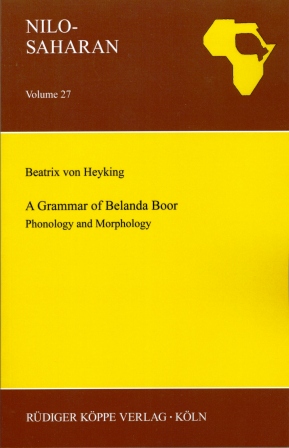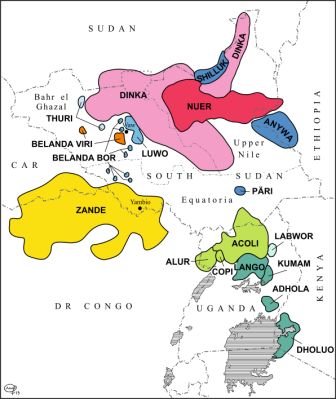

A Grammar of Belanda Boor
Phonology and Morphology
Author: Beatrix von Heyking. Series edited by: Norbert Cyffer, Osamu Hieda, Angelika Mietzner, Doris L. Payne, Anne Storch.
Series: NISA Nilo-Saharan – Studies in Language and Context Volume 27
201312 pp. Roman, 230 pp.
1 colour map, 8 graphs, 12 tables and numerous charts
Text language(s): English
Format: 160 x 240 mm
640 g
Paperback
€ 69.80
Buy 'A Grammar of Belanda Boor' as a downloadable PDF document directly from our online shop »
Order 'A Grammar of Belanda Boor' as print edition »
The Boor are an ethnic group of estimated 8.000 people, distributed in the provinces of Bahr-el-Ghazal and Western Equatoria of South Sudan. Although the arrival of the Boor in the region is believed to have taken place only a rough 300 years ago, this area is perceived by all speakers as their traditional homeland. The Boor language is classified by Storch (2005) as a Nilo-Saharan language, which is further subclassified as Nilotic, Western-Nilotic, Northern-Lwoo. It is the smallest language of the subgroup and closely related to Shilluk, Anywa, Jur, Thuri, Päri and the Southern Lwoo languages. Due to its immense influence, the Ubangi language Belanda Bviri is of great importance to any study of Belanda Boor.
The name Belanda Boor is a composition of the autonym Boor and the Central-Sudanic Bongo word beerlanda. In Bongo, beer is the overall ethnonym for all their Lwoo speaking neighbours whereas landa means ‘hill, mountain’ the composite thus referring to the Lwoo of the hills, the hill dwellers. Today this rather descriptive Bongo name includes the genetically unrelated group of the Ubangian Bviri. The name therefore highlights one of the most defining aspects for both the language and the community of speakers: the close alliance with the Ubangian Bviri. The intriguing facts lie in the persisting bilingualism of the speakers and a conservation of the Lwoo lexicon while the grammar shows a progressing structural convergence.
The incentives for a linguistic study of Belanda Boor chiefly originated from two aspects: first of all, Boor was a nearly undocumented language, and second, it promised most interesting insights concerning the implications of language contact. The main basis for this work was provided by data gathered during two periods of intensive fieldwork conducted in Khartoum in 2007.
The intention of this work is to provide a descriptive grammar in accordance with Basic Linguistic Theory. The realm of this volume is however restricted to the phonology and morphology of the language. Syntax and pragmatic are intended to be described in a following volume. Thus this study comprises first an overview of the phonology of Boor dealing with the inventory of phonemes, the phonologic processes as well as the consideration of historic changes, and a second part dedicated to the morphology.
This part is organised in several chapters. Here the noun, the noun phrase and the pronominals are described. A further chapter is dedicated to the documentation of the verb and the verbal system. Concluding the description of the different word classes are two subsequent chapters on closed word classes and ideophones. Finally in form of a last chapter a conclusion is drawn.
Under these links you will find further publications by the author:
Accompanying material:
Reviews
Heyking’s book is concise and readable, with grammatical topics organized according to a logical outline. The discussions introducing each section as well as the cross-section references to related topics are helpful for guiding the reader. Heyking makes tremendous use of the literature for language comparisons and historical insights. She is more than generous with data examples to illustrate each point. Boor grammar involves independent morphemes in clause structure to a higher degree than bound morphemes and alternations. Thus, the numerous interlinearized examples are particularly helpful in illustrating the meaning and function of the various morphemes. [...]
As a field linguist who benefits from documentation and analysis, I appreciate Heyking’s treatment of the grammar from a framework neutral perspective. She briefly refers to frameworks for assisting in the understanding of noun and verb semantics, but clearly explains other grammar directly. As a result, her data will be especially accessible to language developers and those who assist them.
Descriptive linguists will appreciate the care Heyking takes in separating the phonology of roots from morphophonology and borrowings, as well as the specific and sound anlyses throughout. Historical linguists will appreciate her meticulous comparison of morphemes to those in relatd languages, her claims of where petrified morphemes originated, as well as her explanation of several grammaticalization processes and at what stage the morphemes are in the process. Perhaps sociolinguists will be the most impressed by Heyking’s book, in that she clearly demonstrates how various grammatical features not present in other Western Nilotic languages have been adopted through language contact with the Bviri. [...]
All in all, Heyking’s book is a major contribution to descriptive and comparative linguistics, in that she thoroughly documents the morphosyntax of the Belanda Boor language, and painstakingly compares the grammar with related Western Nilotic languages and unrelated Ubangi languages.
Timothy M. Stirtz in Journal of African Languages and Linguistics, 35/2, 2014, 291-294
| « back | Print version | [top] |
 Books
Books Audio
Audio Biographies
Biographies Series
Series Festschrifts
Festschrifts Journals
Journals